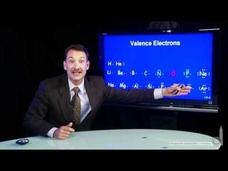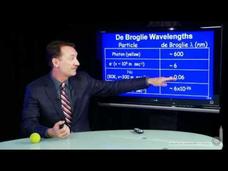Berkeley University of California
The pH Scale
Studying acids and bases can be basic. Over the course of four short videos, an instructor explains the pH scale. Viewers observe a demonstration and watch the instructor solve two quiz questions in detail.
Berkeley University of California
Oxidation Bond Angle (NB)
What is the show Caesium and Iodine love watching together? CsI. The first video explains how to determine the bond angle of an oxidation. The second focuses on how to determine which are linear ions by using molecular geometry.
Berkeley University of California
Isomers: Stereo (Chiral)
In the 50s and 60s, pregnant women were prescribed Thalidomide, a stereoisomer that prevented morning sickness but caused severe birth defects. The instructor in the videos explain stereoisomers, enantiomers, and chirality using...
Berkeley University of California
Isomers
Why did the two dipoles start going out? Because they had a moment. The video briefly explains isomers and the difference between structural isomers and stereo isomers before diving into the importance of defining dipole...
Berkeley University of California
Molecular Structure and Geometry
While physics is known for the math connections, chemistry is know for geometric connections. The 11th video in the series discusses how to determine the molecular structure of bonded atoms in a 3-D plane using steric numbers.
Berkeley University of California
Bond Order (Quiz)
What is the name of 007's Eskimo cousin? Polar Bond. The video contains a one-question quiz on whether bond order is increasing, decreasing, or staying the same in an oxidation reaction.
Berkeley University of California
Covalent Bonding
You have a joke about covalent bonds? Do share! Discussing the difference in ionic and covalent bonding, the video focuses on electron sharing and molecular orbitals. Video is the third in a series of 15.
Berkeley University of California
Ionic Bonding
This instructional video explains how bonds are formed between different atoms. It discusses valence electrons, charges, electron transfer, and Coulomb attraction. It is the second in a 15-part series.
Berkeley University of California
Lewis Electron Dot Structures
You think all of the good periodic table jokes argon? I don't zinc so! Video discusses electron dot structures based on valence electrons. It highlights the arrangement of the periodic table and the stability of the noble gasses. This is...
Berkeley University of California
Oxidation Number (Quiz)
The video contains a one-question quiz over oxidation numbers, solved with the electron dot structure. It is the seventh in a series of 15 chemistry lessons.
Berkeley University of California
Octet Rule
What did sodium say to chloride? You complete me! The video goes over the octet rule for bonding. It introduces the concept of double and triple bonds and references the electron dot structure and valence electrons. Video is the...
Berkeley University of California
pH of Weak Base Solution (NB)
Young chemists solve for the pH of a weak base solution. Using the information from the video, they complete an assessment quiz.
Berkeley University of California
Weak Acid - Weak Base
How do you tell a plumber from a chemist? Ask them to pronounce unionized. The first video in the set demonstrates the pH and conduction of ions based on their acid and base strengths. The next two videos are quizzes that apply the...
Berkeley University of California
Weak Acid/Base
Want to hear a joke about nitric oxide? NO! A chemistry video features an instructor adding a weak base to a weak acid, adding a weak acid to a weak base, and offers a one question quiz on pH. This is the 10th set of videos in a...
Berkeley University of California
Strong Acid and Indicator+Base (NB)
What happens when you mix a strong base into a strong acid and the resulting pH change? Explore this reaction with a demonstrative chemistry video. This is the ninth video in a series of 13.
Berkeley University of California
Ionization, Dissociation
Two chemistry videos cover the topics of ionization, dissociation, autoionization, and autodissociation. They also also discuss an example problem for each topic.
Berkeley University of California
Acid Base Equilibrium
The best part of equilibrium is that nothing changes. A video offers a simple definition of acids and bases, common acids and bases, and their conjugates.
Berkeley University of California
Conductometric Titration
What did one titration say to the other titration? Let's meet at the end point. The first video explains titration, while the second installment contains a one-question quiz and a demonstration of titration.
Berkeley University of California
Solubility of Ionic Solids
Scholars first learn about Le Chatelier's principle with a two-video set. They then apply their knowledge to a short quiz.
Berkeley University of California
Conjugate Acid/Base Pair
A set of three videos starts with the instructor explaining acid and base conjugate pairs. Then, two one-question quizzes reinforce knowledge.
Berkeley University of California
Strong Acid-Base Titration
A chemistry instructor explains titration with strong acids and bases in a series of three videos. Learners then demonstrate their understanding with two short quizzes. This is the eighth set of videos in a series of 13 sets.
Berkeley University of California
Solubility (NB)
Focus on the basics of solubility in chemistry with an explanatory video, which focuses on how to solve solubility problems and common ion effect calculations.
Berkeley University of California
Heterogeneous Equilibrium
When performing a gas lab, we are often under pressure. A four-video set offers a brief explanation of Henry's law and demonstrates a lab. The last two videos prompt learners to complete brief quizzes over the material.
Berkeley University of California
De Broglie Wavelengths
You learned in the previous lesson in this series that a particle with momentum has the properties of a wave. So how about a baseball? The lesson calculates the wavelengths of different particles given their momentum (mass and velocity),...























